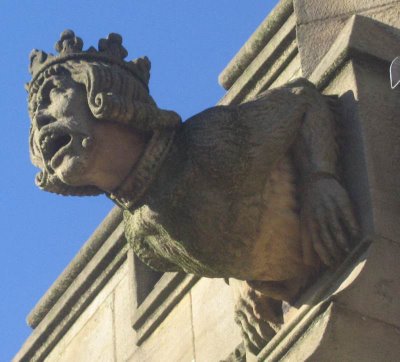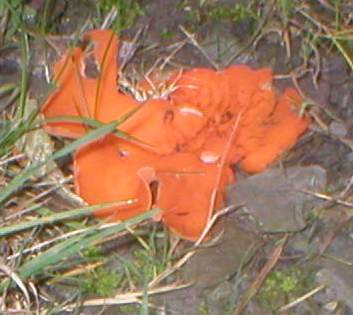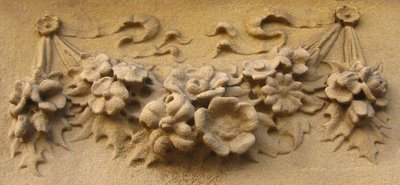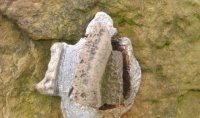

St. Chad's parish Church, Rochdale with one of the gargoyles.
There was, the site indicates, a Church on Sparrow Hill long before 1194.
A wall, reputedly of Saxon origin, still stands to the north of the present edifice. Legend insists that Rochdale was a town visited by St. Chad in 669 or 670 and to whom the Church has ever been dedicated. It is a legend unsupported by historical evidence, but it is not improbable: Rochdale was a town of some importance in the Middle Ages, as is evidenced by the establishment of a market in the year 1251. The local references to a Castle both in site, and in names like Castlemere and Castleton, indicate an importance for Rochdale that was not insignificant, and when the town expanded in the time of the Industrial Revolution, it remained one of the most important in this part of Lancashire.
The bottom of the Church tower together with the alternating round and octagonal pillars in the Nave date from the time of the first Vicar, Geoffrey of Whalley who was Vicar in the year 1194. He owed his appointment to the local de Lacy family, powerful representatives of the King.
The Church is known as a 'Double Apostle' building due to the number of arches, its size was doubled in the 1880's being completed in 1888 during Canon Maclure's incumbency. This had the effect of making the section alotted to the Choir slightly larger than that allotted to the congregation, the intention being to adopt the style of a Cathedral. The clerestory windows picture the Apostles.
The older parts of the church is built in millstone grit while the extension is of Yorkshire sandstone.
The Octingentenary (800 year anniversary) was marked on December 1st 1994 by a visit from Her Majesty, The Queen and His Royal Highness, The Duke of Edinburgh.
Bet Lynch was married here.

 Signs of the Times
Signs of the Times

 Persimmon Homes are building houses at Newbold. The sign tells the tale. What is basically a terrace house with a parking spot sells for about £165K.
Persimmon Homes are building houses at Newbold. The sign tells the tale. What is basically a terrace house with a parking spot sells for about £165K.

 An impressive and commanding obelisk with a disappointing tablet - presumably vandal proof.
An impressive and commanding obelisk with a disappointing tablet - presumably vandal proof.






 Coprinus atramentarius (Bull.: Fr.) one of the Ink cap fungi growing in Rochdale cemetery today. (Polish czernidłak pospolity)
Coprinus atramentarius (Bull.: Fr.) one of the Ink cap fungi growing in Rochdale cemetery today. (Polish czernidłak pospolity) Although edible it is not advisable to eat it. The mushrooms contain coprine, a toxin similar to disulfiram, [bis(diethylthiocarbonyl)disulfide] the ingredient in the drug Antabuse, given to alcoholics. Coprine is unusual amino acid, a derivative of glutamic acid, which converts to cyclopropanone hydrate in the human body. Like Antabuse, the Ink Cap produces no ill effects -- unless one consumes alcohol, which will trigger nausea, vomiting, rash, dizziness, and so on.
Although edible it is not advisable to eat it. The mushrooms contain coprine, a toxin similar to disulfiram, [bis(diethylthiocarbonyl)disulfide] the ingredient in the drug Antabuse, given to alcoholics. Coprine is unusual amino acid, a derivative of glutamic acid, which converts to cyclopropanone hydrate in the human body. Like Antabuse, the Ink Cap produces no ill effects -- unless one consumes alcohol, which will trigger nausea, vomiting, rash, dizziness, and so on. A great deal of information / photographs to help identification / sightings / records are available at Rochdale Field Naturalists website.
A great deal of information / photographs to help identification / sightings / records are available at Rochdale Field Naturalists website. This is one of the 2 Gate Houses of Rochdale Cemetery which has been greatly neglected.
This is one of the 2 Gate Houses of Rochdale Cemetery which has been greatly neglected.

 Falinge park (13 acres)given to Rochdale by Alderman Samuel Turner (Mayor 1901-3) in commemeoration of the Coronation of King Edward VII on 5th August 1905.
Falinge park (13 acres)given to Rochdale by Alderman Samuel Turner (Mayor 1901-3) in commemeoration of the Coronation of King Edward VII on 5th August 1905. Mount Falinge (only the windoless facade exists today, heavily fenced off and neglected) was built by Clement Royds, his son Albert Hudson Royds, was the grandfather of Alderman Turner.
Mount Falinge (only the windoless facade exists today, heavily fenced off and neglected) was built by Clement Royds, his son Albert Hudson Royds, was the grandfather of Alderman Turner.
 In the middle of the 19th Century a series of Boundary Stones were erected 1 mile from the centre (?) of Rochdale.
In the middle of the 19th Century a series of Boundary Stones were erected 1 mile from the centre (?) of Rochdale.
 The Post Office on the Esplanade in the centre of Rochdale was built in 1927 by the famous firm of R & T Howarth, who built many familiar buildings in Rochdale.
The Post Office on the Esplanade in the centre of Rochdale was built in 1927 by the famous firm of R & T Howarth, who built many familiar buildings in Rochdale. The Free Trade Tavern...where else is there a pub named after a Political Idea ? The Ramada Inn where our Dear Leader laid his head last week at the Labour Party Conference used to be the Free Trade Hall but that (on the site of Peterloo) is an unhealthy reference to our socialist past.
The Free Trade Tavern...where else is there a pub named after a Political Idea ? The Ramada Inn where our Dear Leader laid his head last week at the Labour Party Conference used to be the Free Trade Hall but that (on the site of Peterloo) is an unhealthy reference to our socialist past. Rochdale born John Milne (1850 – 1913) after training as a geologist, he emigrated to Japan and to take up the post of Professor of mining and geology at the Imperial College of Engineering in Tokyo.
Rochdale born John Milne (1850 – 1913) after training as a geologist, he emigrated to Japan and to take up the post of Professor of mining and geology at the Imperial College of Engineering in Tokyo.
 Email
Email